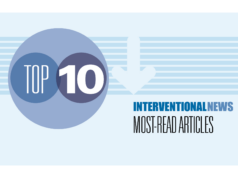 In November, the most read stories from Interventional News included a profile of current Society of Interventional Oncology (SIO) president, Muneeb Ahmed (Beth Israel Deaconess Medical Center, Boston, USA); an update on liquid biopsy and its application in interventional radiology practice according to Bruno Damascelli (Fondazione Falciani ONLUS, Milan, Italy) et al; and two-year SPYRAL HTN-ON MED results regarding renal denervation.
In November, the most read stories from Interventional News included a profile of current Society of Interventional Oncology (SIO) president, Muneeb Ahmed (Beth Israel Deaconess Medical Center, Boston, USA); an update on liquid biopsy and its application in interventional radiology practice according to Bruno Damascelli (Fondazione Falciani ONLUS, Milan, Italy) et al; and two-year SPYRAL HTN-ON MED results regarding renal denervation.
1. Interventional radiology: A play in three acts
Andreas Adam, emeritus professor of interventional radiology at King’s College London, UK and joint editor-in-chief of Interventional News, writes on his path to becoming an interventional radiologist: “I became an interventional radiologist by accident. As a resident in cardiology, I had an unusual chief: he belonged to a new breed of cardiologists…”
2. Profile: Muneeb Ahmed
Tracing back his line to interventional radiology (IR), Muneeb Ahmed, interventional radiologist and the current president of the Society of Interventional Oncology (SIO), told Interventional News of how he followed in the footsteps of his father, Rashid Ahmed, an influential interventional radiologist who propelled the field in Pakistan.
3. iVascular initiates Opal study with new embolic liquid
iVascular has announced the initiation of Opal, the first-in-human study with the new embolic liquid Amber, based on a radiopaque biocompatible copolymer. Opal is a prospective, single-arm, multicentre study with a sample size of 70 patients requiring peripheral embolization. The study is a collaboration between 10 centres in Spain that specialise in embolization and will be led by Fernando Gómez (Hospital La Fe, Valencia, Spain).
4. Boston Scientific announces acquisition of Intera Oncology
Boston Scientific has announced it has entered into a definitive agreement to acquire Intera Oncology. Intera Oncology’s Intera 3000 hepatic artery infusion pump has been approved by the US Food and Drug Administration (FDA) and is used to administer hepatic artery infusion (HAI) therapy to treat tumours in the liver primarily caused by metastatic colorectal cancer.
5. Liquid biopsy shows what you have been missing
Where is liquid biopsy today? Bruno Damascelli, Vladimira Tichà, Giancarlo Beltramo, Alberto Gramaglia and Gianluigi Patelli write on the complexities and challenges of the procedure as it gains ground among select interventional radiologists.
6. TCT 2024: Two-year SPYRAL HTN-ON MED show “consistent” effect of renal denervation
Medtronic has announced new, long-term data from the SPYRAL HTN-ON MED clinical trial that showed subjects who underwent radiofrequency renal denervation with the Symplicity Spyral renal denervation system had significantly greater reductions in 24-hr ambulatory systolic blood pressure, and office-based systolic blood pressure compared to sham patients at two years.
7. Clinical IR practice often goes unseen due to lack of distinct performance metrics in Australia
In a paper published last month in the journal CardioVascular and Interventional Radiology (CVIR), Matthew Lukies and colleagues from Alfred Health in Melbourne, Australia have released data collected from their institution giving visibility to the clinical interventional radiology (IR) service that they state has gone largely unnoticed.
8. US interventional radiology: 12 years of primary specialty status
Interventional radiology (IR) was officially recognised as a primary medical specialty in the USA by the American Board of Medical Specialties (ABMS) in 2012. This marked a significant milestone for the field, which had previously been considered a subspecialty of diagnostic radiology (DR). With 12 years of specialty distinction, Interventional News spoke to Parag Patel (Medical College of Wisconsin, Milwaukee, USA) who debriefed on their progress so far.
9. Two-year LIFE-BTK data show sustained benefits of drug-eluting resorbable scaffold for below-the-knee arteries
Presented today, late-breaking data from the second year of the LIFE-BTK clinical trial demonstrate the long-term effectiveness of the US Food and Drug Administration (FDA)-approved Esprit BTK everolimus-eluting resorbable scaffold system (Abbott Vascular) in patients with the most severe form of below-the-knee (BTK) peripheral arterial disease (PAD). The data show that the Esprit BTK offers sustained benefits over balloon angioplasty with fewer repeat procedures at two years.
10. Fluidx Medical announces first patient treated in prospective trial
Fluidx Medical has announced that the first patient has been treated in the GPX investigational device exception (IDE) prospective multinational clinical trial. The GPX embolic device was successfully used in a portal vein embolization procedure in preparation for hepatic resection.









